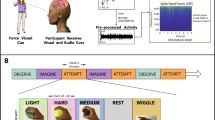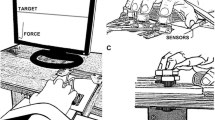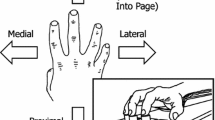Abstract
Multifinger dexterous manipulation of unstable or deformable objects requires control of both direction and magnitude of fingertip force vectors. Our aim was to study the neuroanatomical correlates of these two distinct control functions. Brain activity was measured using functional magnetic resonance imaging while 16 male subjects (age: 26–42, M = 32, SD ± 4 years) compressed four springs representing a 2 × 2 factorial design with two levels of force and instability requirements. Significant activations associated with higher instability were located bilaterally in the precentral gyri, the postcentral gyrus, and the cerebellum. In the main effect for high force, activity was found in areas located in the primary motor regions contralateral to the active hand and bilaterally in the cerebellum. An overlap in activation between the two main effects was found bilaterally in the cerebellum (lobule VI). This study not only confirms a recently described bilateral fronto-parieto-cerebellar network for manipulation of increasingly unstable objects, but critically extends our understanding by describing its differentiated modulation with both force magnitude and instability requirements. Our results, therefore, expose a previously unrecognized and context-sensitive system of brain regions that enable dexterous manipulation for different force magnitude and instability requirements of the task.



Similar content being viewed by others
References
Ashburner J, Friston K (1997) Multimodal image coregistration and partitioning—a unified framework. Neuroimage 6(3):209–217
Binkofski F, Buccino G, Posse S, Seitz RJ, Rizzolatti G, Freund H (1999a) A fronto-parietal circuit for object manipulation in man: evidence from an fMRI-study. Eur J Neurosci 11(9):3276–3286
Binkofski F, Buccino G, Stephan KM, Rizzolatti G, Seitz RJ, Freund HJ (1999b) A parieto-premotor network for object manipulation: evidence from neuroimaging. Exp Brain Res 128(1–2):210–213
Bursztyn LL, Ganesh G, Imamizu H, Kawato M, Flanagan JR (2006) Neural correlates of internal-model loading. Curr Biol 16(24):2440–2445
Dafotakis M, Sparing R, Eickhoff SB, Fink GR, Nowak DA (2008) On the role of the ventral premotor cortex and anterior intraparietal area for predictive and reactive scaling of grip force. Brain Res 1228:73–80
Duvernoy HM (1999) The human brain: surface, blood supply and three-dimensional sectional anatomy. Springer, Wien
Ehrsson HH, Fagergren A, Jonsson T, Westling G, Johansson RS, Forssberg H (2000) Cortical activity in precision- versus power-grip tasks: an fMRI study. J Neurophysiol 83(1):528–536
Ehrsson HH, Fagergren E, Forssberg H (2001) Differential fronto-parietal activation depending on force used in a precision grip task: an fMRI study. J Neurophysiol 85(6):2613–2623
Ehrsson HH, Kuhtz-Buschbeck JP, Forssberg H (2002) Brain regions controlling nonsynergistic versus synergistic movement of the digits: a functional magnetic resonance imaging study. J Neurosci 22(12):5074–5080
Ehrsson HH, Fagergren A, Johansson RS, Forssberg H (2003) Evidence for the involvement of the posterior parietal cortex in coordination of fingertip forces for grasp stability in manipulation. J Neurophysiol 90(5):2978–2986
Eickhoff SB, Stephan KE, Mohlberg H, Grefkes C, Fink GR, Amunts K, Zilles K (2005) A new SPM toolbox for combining probabilistic cytoarchitectonic maps and functional imaging data. Neuroimage 25(4):1325–1335
Flanagan JR, Wing AM (1997) The role of internal models in motion planning and control: evidence from grip force adjustments during movements of hand-held loads. J Neurosci 17(4):1519–1528
Flanagan JR, Bowman MC, Johansson RS (2006) Control strategies in object manipulation tasks. Curr Opin Neurobiol 16(6):650–659
Friston KJ, Ashburner J, Frith CD, Poline JB, Heather JD, Frackowiak RSJ (1995) Spatial registration and normalization of images. Hum Brain Mapp 2:165–189
Gallea C, de Graaf JB, Bonnard M, Pailhous J (2005) High level of dexterity: differential contributions of frontal and parietal areas. Neuroreport 16(12):1271–1274
Genovese CR, Lazar NA, Nichols T (2002) Thresholding of statistical maps in functional neuroimaging using the false discovery rate. Neuroimage 15(4):870–878
Jenmalm P, Schmitz C, Forssberg H, Ehrsson HH (2006) Lighter or heavier than predicted: neural correlates of corrective mechanisms during erroneously programmed lifts. J Neurosci 26(35):9015–9021
Johansson RS, Flanagan JR (2009) Coding and use of tactile signals from the fingertips in object manipulation tasks. Nat Rev Neurosci 10(5):345–359
Johansson RS, Westling G (1988) Coordinated isometric muscle commands adequately and erroneously programmed for the weight during lifting task with precision grip. Exp Brain Res 71(1):59–71
Kawato M (1999) Internal models for motor control and trajectory planning. Curr Opin Neurobiol 9(6):718–727
Kawato M, Kuroda T, Imamizu H, Nakano E, Miyauchi S, Yoshioka T (2003) Internal forward models in the cerebellum: fMRI study on grip force and load force coupling. Prog Brain Res 142:171–188
Kuhtz-Buschbeck JP, Ehrsson HH, Forssberg H (2001) Human brain activity in the control of fine static precision grip forces: an fMRI study. Eur J Neurosci 14(2):382–390
Kuhtz-Buschbeck JP, Gilster R, Wolff S, Ulmer S, Siebner H, Jansen O (2008) Brain activity is similar during precision and power gripping with light force: an fMRI study. Neuroimage 40(4):1469–1481
Kwong KK, Belliveau JW, Chesler DA, Goldberg IE, Weisskoff RM, Poncelet BP, Kennedy DN, Hoppel BE, Cohen MS, Turner R et al (1992) Dynamic magnetic resonance imaging of human brain activity during primary sensory stimulation. Proc Natl Acad Sci U S A 89(12):5675–5679
Mayka MA, Corcos DM, Leurgans SE, Vaillancourt DE (2006) Three-dimensional locations and boundaries of motor and premotor cortices as defined by functional brain imaging: a meta-analysis. Neuroimage 31(4):1453–1474
Milner TE, Franklin DW, Imamizu H, Kawato M (2006) Central representation of dynamics when manipulating handheld objects. J Neurophysiol 95(2):893–901
Milner TE, Franklin DW, Imamizu H, Kawato M (2007) Central control of grasp: manipulation of objects with complex and simple dynamics. Neuroimage 36(2):388–395
Mosier KM, Lau C, Wang Y, Venkadesan M, Valero-Cuevas FJ (2011) Controlling instabilities in manipulation requires specific cortical-striatal-cerebellar networks. J Neurophysiol 105(3):1295–1305
Nichols T, Brett M, Andersson J, Wager T, Poline JB (2005) Valid conjunction inference with the minimum statistic. Neuroimage 25(3):653–660
Ogawa S, Tank DW, Menon R, Ellermann JM, Kim SG, Merkle H, Ugurbil K (1992) Intrinsic signal changes accompanying sensory stimulation: functional brain mapping with magnetic resonance imaging. Proc Natl Acad Sci USA 89(13):5951–5955
Ohki Y, Edin BB, Johansson RS (2002) Predictions specify reactive control of individual digits in manipulation. J Neurosci 22(2):600–610
Olivier E, Davare M, Andres M, Fadiga L (2007) Precision grasping in humans: from motor control to cognition. Curr Opin Neurobiol 17(6):644–648
Talati A, Valero-Cuevas FJ, Hirsch J (2005) Visual and tactile guidance of dexterous manipulation tasks: an fMRI study. Percept Mot Skills 101(1):317–334
Tanaka Y, Fujimura N, Tsuji T, Maruishi M, Muranaka H, Kasai T (2009) Functional interactions between the cerebellum and the premotor cortex for error correction during the slow rate force production task: an fMRI study. Exp Brain Res 193(1):143–150
Valero-Cuevas FJ, Smaby N, Venkadesan M, Peterson M, Wright T (2003) The strength-dexterity test as a measure of dynamic pinch performance. J Biomech 36(2):265–270
Vollmer B, Holmstrom L, Forsman L, Krumlinde-Sundholm L, Valero-Cuevas FJ, Forssberg H, Ullen F (2010) Evidence of validity in a new method for measurement of dexterity in children and adolescents. Dev Med Child Neurol 52(10):948–954
Acknowledgments
This work was supported by the Swedish Research Council (5925), Swedish Foundation for Strategic Research, VINNOVA, Foundation Frimurare Barnhuset, Strategic Neuroscience Program at Karolinska Institutet and Knut and Alice Wallenberg, Foundation Stiftelsen Olle Engkvist Byggmästare. BV was funded by a Marie Curie Intra-European Fellowship within the EU FP6 Framework Programme. This work was supported in part by grants (to FVC) NSF 0237258, and NIH HD048566 and AR050520. The authors are thankful to Peter Fransson, Ph.D., for his comments on the initial design of the fMRI paradigm, and to Kristine Mosier, DMD, Ph.D., for her insightful comments and suggestions on the manuscript.
Author information
Authors and Affiliations
Corresponding author
Rights and permissions
About this article
Cite this article
Holmström, L., de Manzano, Ö., Vollmer, B. et al. Dissociation of brain areas associated with force production and stabilization during manipulation of unstable objects. Exp Brain Res 215, 359–367 (2011). https://doi.org/10.1007/s00221-011-2903-9
Received:
Accepted:
Published:
Issue Date:
DOI: https://doi.org/10.1007/s00221-011-2903-9




